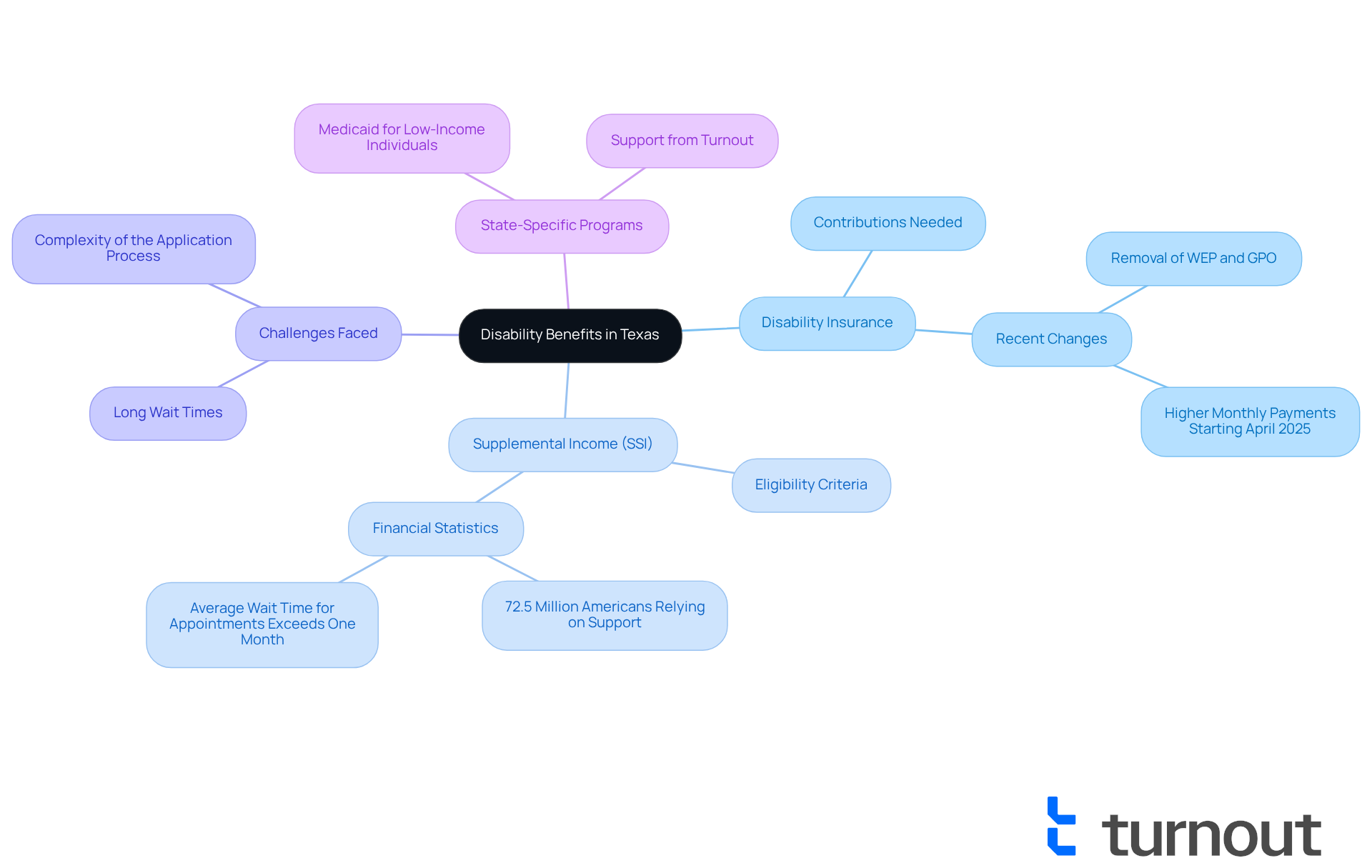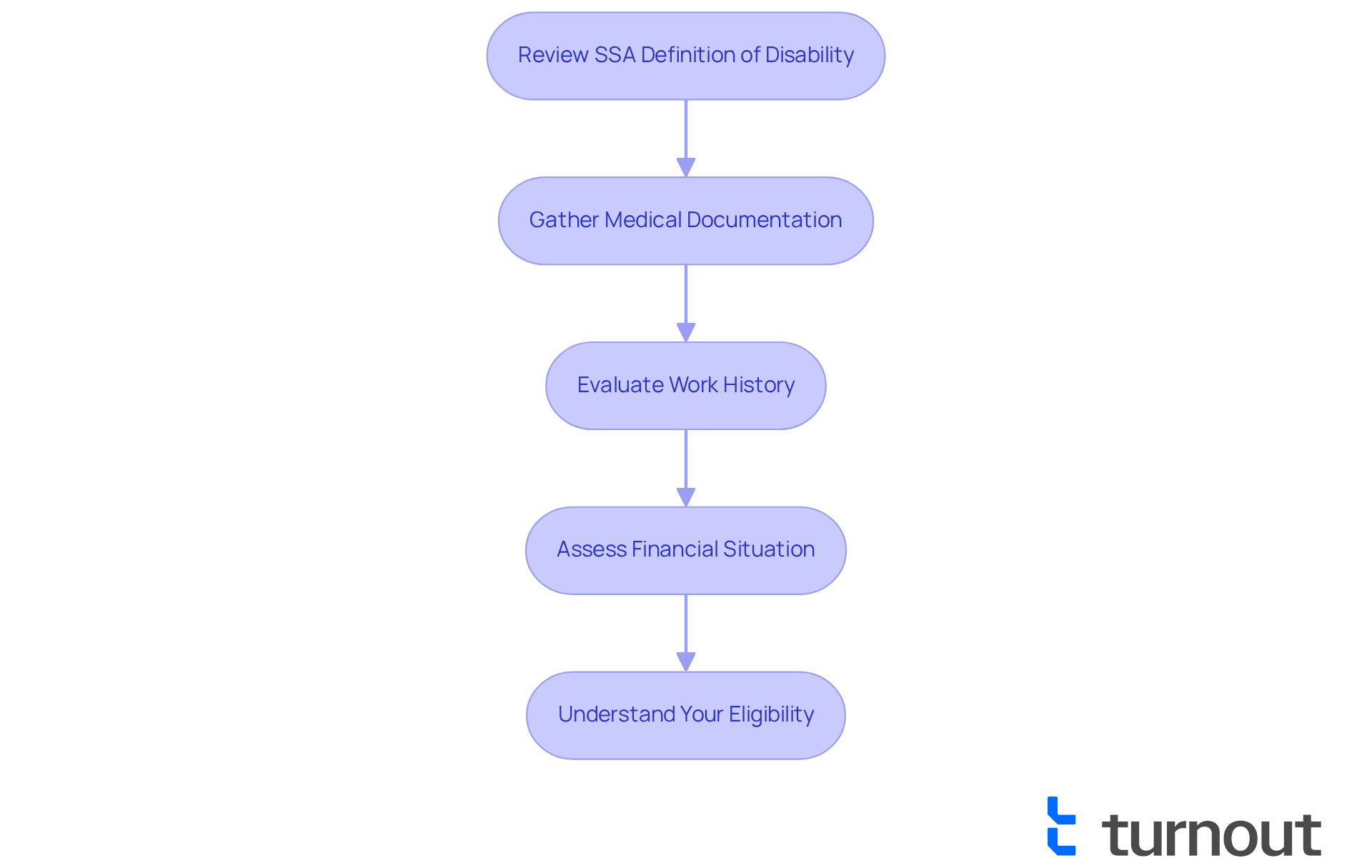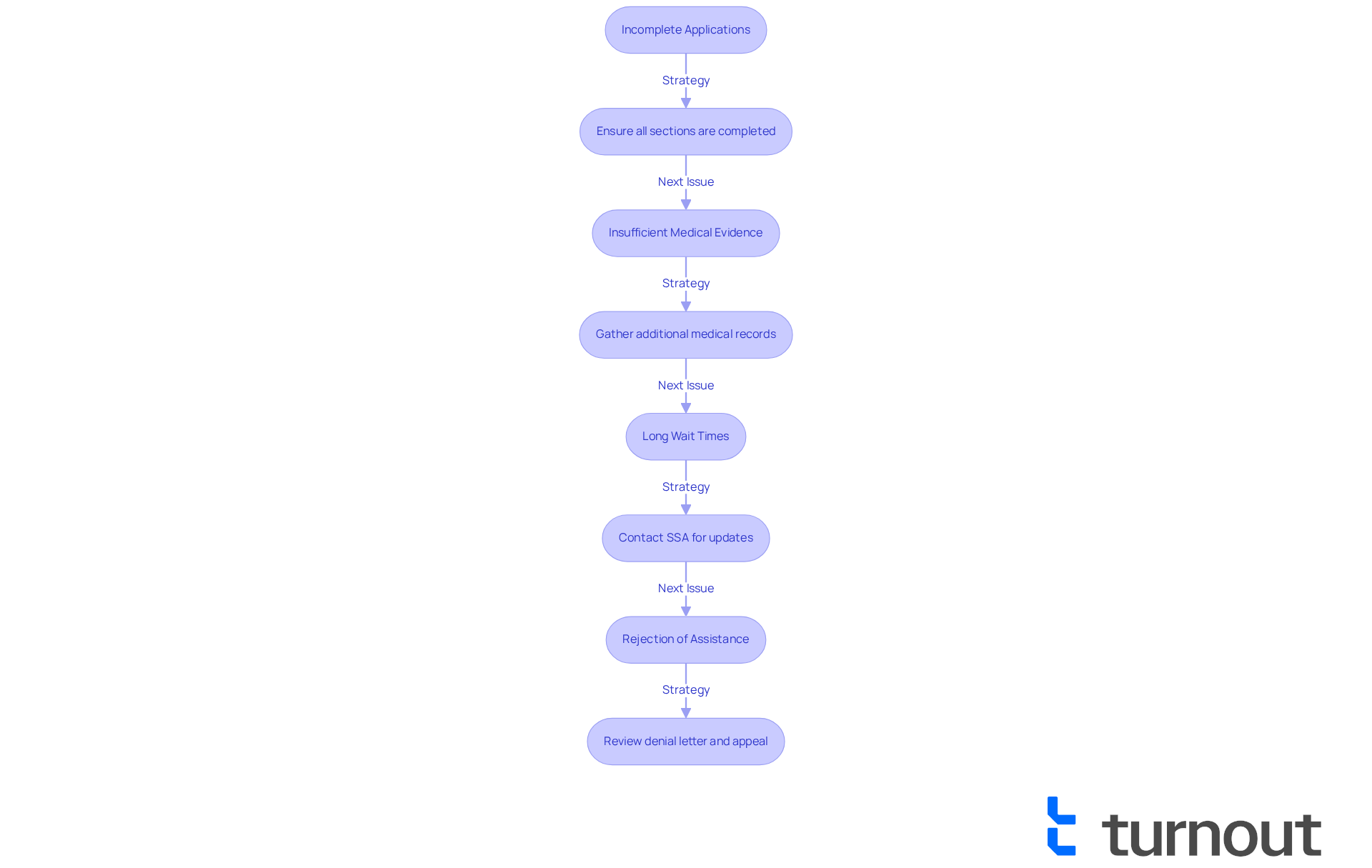Overview
Navigating the world of disability benefits in Texas can feel overwhelming, and we understand that. This article is here to guide you through the essential steps to calculate your benefits, focusing on understanding the sources of assistance, determining eligibility, calculating benefit amounts, and troubleshooting common application issues.
Knowing how much disability benefits are available is crucial for you, as it directly impacts your financial support and eligibility. We’ll break down the details of SSDI and SSI calculations, addressing common challenges you might face during the application process.
Here’s what you can expect:
- Understanding Sources of Assistance: Learn where to find the help you need.
- Determining Eligibility: Discover if you qualify for benefits.
- Calculating Benefit Amounts: Get clarity on how much you can receive.
- Troubleshooting Application Issues: Find solutions to common problems.
It’s common to feel uncertain about the process, but remember, you are not alone in this journey. We’re here to help you every step of the way. By understanding your options and the calculations involved, you can take control of your financial future.
If you have questions or need further assistance, don’t hesitate to reach out. Your well-being is important, and we’re committed to supporting you through this process.
Introduction
Navigating the complexities of disability benefits in Texas can feel overwhelming. We understand that millions rely on these essential financial supports, and the journey can be daunting. From Disability Insurance to Supplemental Security Income, knowing the types of assistance available is crucial for anyone seeking help.
It's common to feel lost when faced with the intricate eligibility requirements and benefit calculations. Many individuals find themselves uncertain about their next steps. But you’re not alone in this journey. How can you effectively navigate this labyrinth to secure the benefits you deserve?
We’re here to help you understand your options and guide you through the process. Together, we can explore the resources available to you, ensuring you feel supported every step of the way.
Understand Disability Benefits in Texas
In Texas, navigating disability assistance can feel overwhelming. It mainly comes from two sources: Disability Insurance and Supplemental Income. Disability Insurance is for those who have contributed to the social insurance system, while Supplemental Income (SSI) is designed for individuals with limited income and assets. Understanding how much is disability in Texas is crucial, as it directly affects eligibility and the amount of support you can receive.
As of 2025, around 72.5 million Americans rely on financial support, with many in Texas depending on SSDI and SSI. Recent changes, like the removal of the Windfall Elimination Provision (WEP) and Government Pension Offset (GPO), will benefit over 3.2 million individuals, allowing for higher monthly payments starting in April 2025. However, it’s common to feel frustrated when facing long wait times; the average appointment wait at Social Security field offices exceeds one month. This highlights the challenges many encounter while seeking assistance.
We understand that this process can be daunting. That’s where Turnout comes in. They offer essential support to help you navigate these complexities, employing skilled nonlegal advocates to assist with SSD claims. This means you can obtain the support you deserve without the need for legal representation.
Additionally, Texas provides state-specific programs that may offer further assistance, including details on how much is disability in Texas, such as Medicaid for low-income individuals with disabilities. Familiarizing yourself with these options is the first step in effectively navigating the landscape of available benefits. Remember, you are not alone in this journey; we’re here to help you find the support you need.

Determine Eligibility for Disability Benefits
Navigating the process of applying for disability assistance in Texas can feel overwhelming, particularly when trying to understand how much is disability in Texas. We understand that you may have many questions and concerns. To help you, let’s break down the requirements set by the Social Security Administration (SSA) for eligibility.
First, it’s important to know that for Social Security Disability Insurance, having a work history with contributions to Social Security is essential. On the other hand, Supplemental Security Income (SSI) requires proof of financial need. Both programs require that your disability significantly impacts your ability to work.
Here are some steps to guide you through determining your eligibility:
- Review the SSA's definition of disability: This includes having a medical condition expected to last at least one year or result in death.
- Gather medical documentation: Collect comprehensive records from healthcare providers that detail your condition and its impact on daily life.
- Evaluate your work history: Ensure you have adequate work credits based on your age and employment record.
- Assess your financial situation: For SSI, verify that your income and resources fall below the limits set by the SSA.
By thoroughly assessing these factors, you can better understand your eligibility and prepare for the next steps in the application process. It’s common to feel uncertain about how much is disability in Texas, particularly given the challenges faced by the percentage of disability applicants. As of August 2025, many are still navigating this complex landscape.
Looking ahead, the SSA is set to release an update in October 2025, which may provide additional insights into eligibility trends and benefits calculations. Remember, you are not alone in this journey. We’re here to help you every step of the way.

Calculate Your Disability Benefit Amount
Understanding your disability benefits can feel overwhelming, but we're here to help you navigate this journey. Let’s break down how the Social Security Administration (SSA) determines payments for SSDI and SSI, so you can feel more confident about what to expect.
For SSDI: Your payment amount is based on your average lifetime earnings covered by Social Security. Using the SSA's online calculator can be a helpful tool to estimate your monthly payment. Generally, the more you’ve earned throughout your career, the higher your benefit will be. In 2025, the maximum SSDI payment could reach up to $4,018 per month, depending on your earnings history.
For SSI: The payment amount is fixed and varies based on your living situation and income. As of 2025, the federal support rate for individuals stands at $967 per month, which may be adjusted based on state supplements. To find out your SSI payment, simply subtract any countable income from the federal rate. For example, if your monthly earnings total $200, your SSI payment would be $767.
We understand that comprehending these calculations is essential for assessing your potential benefits. Factors like your living arrangements, additional income, and state-specific adjustments can significantly influence your final compensation amount. Remember, you are not alone in this journey; we’re here to support you every step of the way.

Troubleshoot Common Issues in the Application Process
Navigating the application process for disability assistance can be tough. We understand that many face challenges along the way. Here are some common issues and supportive strategies to help you troubleshoot them:
-
Incomplete applications: It’s crucial to ensure that every section of your application is thoroughly completed. Missing information can lead to unnecessary delays or even denials. Take your time to double-check everything.
-
Insufficient medical evidence: If your application is denied due to a lack of medical documentation, don’t worry. Promptly gather additional records from your healthcare providers. This can significantly strengthen your case and improve your chances.
-
Long wait times: If you encounter delays, it’s common to feel anxious. Reach out to the Social Security Administration (SSA) for updates on your application status. Keeping a detailed record of all communications can be beneficial in tracking your progress.
-
Rejection of assistance: If your application is denied, remember that you have the right to appeal. Carefully review the denial letter to understand the reasons behind it, and gather additional evidence to support your appeal. You are not alone in this journey.
By proactively addressing these common issues, you can enhance your chances of successfully navigating the application process and securing the benefits you deserve. We're here to help you every step of the way.

Conclusion
Understanding the complexities of disability benefits in Texas is crucial for anyone seeking financial support. We know that navigating this landscape can feel overwhelming, but familiarizing yourself with the two primary sources of assistance—Disability Insurance and Supplemental Income (SSI)—can make a significant difference.
Let’s explore the key points together. First, it’s important to grasp the eligibility criteria for both SSDI and SSI. Knowing how benefit amounts are calculated can empower you in this process. Many face challenges during the application, and that’s completely normal. Recent changes in regulations, effective in 2025, may positively impact many applicants, offering hope and new opportunities.
We understand that the journey to securing disability benefits can be daunting. However, staying informed and proactive is essential. By learning about the resources available and seeking support from organizations like Turnout, you can enhance your chances of obtaining the benefits you deserve. Remember, empowerment through knowledge not only aids in navigating the application process but also fosters a sense of community among those facing similar challenges.
You are not alone in this journey. We’re here to help you every step of the way.
Frequently Asked Questions
What are the main sources of disability assistance in Texas?
The main sources of disability assistance in Texas are Disability Insurance and Supplemental Income (SSI). Disability Insurance is for individuals who have contributed to the social insurance system, while SSI is designed for those with limited income and assets.
How many Americans rely on disability benefits, and what is the situation in Texas?
As of 2025, around 72.5 million Americans rely on financial support from disability benefits, with many individuals in Texas depending on Social Security Disability Insurance (SSDI) and SSI.
What recent changes have been made to disability benefits in Texas?
Recent changes include the removal of the Windfall Elimination Provision (WEP) and Government Pension Offset (GPO), which will benefit over 3.2 million individuals by allowing for higher monthly payments starting in April 2025.
What challenges do individuals face when seeking disability assistance in Texas?
A common challenge is facing long wait times, as the average appointment wait at Social Security field offices exceeds one month, which can be frustrating for those seeking assistance.
How can Turnout assist individuals navigating disability claims in Texas?
Turnout offers support by employing skilled nonlegal advocates to help with SSD claims, allowing individuals to obtain the support they deserve without needing legal representation.
Are there state-specific programs for disability assistance in Texas?
Yes, Texas provides state-specific programs that may offer further assistance, including Medicaid for low-income individuals with disabilities.
What is the first step to effectively navigate disability benefits in Texas?
Familiarizing yourself with the available options and programs is the first step in effectively navigating the landscape of disability benefits in Texas.




